This paper deals with a algorithm developed for load flow problems in electrical power systems. Jacobian matrix in Newton Raphson method require large computer memory and take more computation time in calculations. Schur complement method can be reduce memory required by divided Jacobian matrix into two separated matrices with reasonable computation time. The proposed algorithm used this method with threshold technique in order to test different power systems. Results has been compared with Newton Raphson method and Fast Decoupled method in term of influence of convergence properties and algorithm efficiency.
Keywords |
| Power system network, Load flow, Element incidence matrix, Schur complement method, Software
Development. |
INTRODUCTION |
| Power flow analysis is necessary for planning, operation, economic scheduling and exchange of power between
utilities. Power flow analysis is required for many other analyses such as transient stability, optimal power flow and
contingency studies. The principal information of power flow analysis is to find the magnitude and phase angle of
voltage at each bus and the real and reactive power flowing in each transmission lines. Power flow problem could be
viewed as a multi-input multi-output system. Each input could have effect on each of the outputs, more or less. Thus it
makes it more difficult to appreciate the correlation between these variables. |
| In view of the topological specialty of transmission and distribution networks, many researchers has proposed several
special load flow techniques [1-4]. However, an acceptable load flow method should meet the requirements such as
high speed and low storage requirements, highly reliable, and accepted versatility and simplicity. The starting of studies
for the load flow calculations was begin with the Ward & Hale [1] , while the Newton-Raphson (N-R) method [2], [3]
are being widely used. The problem of the computation iteration time has been solved by the developments of the Fast
Decoupled Load Flow [4], then Fast Load Flow Method Retaining Nonlinearity [5], and so on. A large variety of
proposed solution for power flow problem addressing with different targets like reduce computation time [6-9], illconditioned
cases and robustness [10–12], and optimal power flow (OPF) problems [10-15]. |
| Based on matrix theory, this paper used Schur complement which shows that the indices obtained from reduced
Jacobian matrix and 2 * 2 matrix are also independent of bus number order which has better properties to find solution
and mostly convergence smoothly. Reduce effect of reactive power values on correlation of voltage angle variables
has been considered by filtering low effect values with corresponding to other high value. Consequently, less memory
and reasonable computation time required to optimize the results. It should be pointed out that modification proposed in
this paper is compared to the Newton Raphson method and Fast Decoupled method to got reasonable accuracy,
competition times and less computer memory respectively. |
LOAD FLOW FOR POWER SYSTEM |
| This method requires the construction of admittance (n x n) matrix, where n is number of bus system. The diagonal
elements of the admittance matrix represent the self-admittance of the bus and the off diagonal represent the mutual
admittance between buses. |
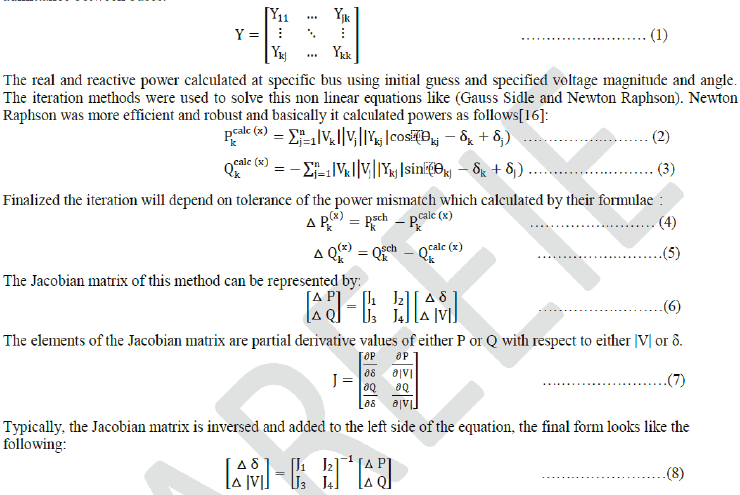 |
| All unknown voltage magnitudes and angles would initially require a guess would be 1 and 0 respectively. As far as
concern, Buses and parameters classified as : |
 |
THE SCHUR COMPLEMENT |
| In linear algebra and the theory of matrices, The sub-domain problems usually involve interior, local interface and
external interface variables. The Schur complement technique is a procedure to eliminate the interior variables in each
sub-domain and derive a global, reduced in size, linear system involving only the interface variables [17]. Suppose that
the square matrix (M) dimensioned (r+s)×(r+s), is partitioned into four sub matrix blocks as A, B, C and D
respectively r×r, r×s, s×r and s×s matrices, and D is invertible. Let |
 |
| Because the data dependencies are not regular as in Fig.(1), Schur method can be used to separate the unknown
variables in interface unknown variables and sub-domain internal unknown variables [18]. That mean, no need for large
memory when inverse matrix which will be more powerful in iteration methods by separate their variables. In practice,
one needs D to be well-conditioned in order for this algorithm to be numerically accurate. |
RESULT AND ALGORITHM |
| After study and analysis Newton Raphson method to understanding the behaviour of Jacobian Matrix during iterations
for different systems (5, 14 and 30 bus), it was noted that values of few elements will slightly changed at beginning of
iterations while mostly of them still constants during all iterations. Figures bellow explain this fact: |
| That mean convergence and divergence will followed the main element values of Jacobian (derivative values) and it is
not changed at each iterations. Problems concerning the convergence or divergence tend to be difficult because there
are many of roots for each case. Most of ill conditional cases appear to surf ace when system has low R and X line
values which effect on solution and it will be fluctuated (Up – Down) near point of root as in fig.(5). These factors will
constraining convergence and delivering divergence. |
| The Schur complement (SC) method can be eliminate or reduce the off-diagonals effects, when it has high values, of
Jacobian matrix which make it close to be singular. This matrix will divided to 4 sub-matrices. That mean, it will have
separated equations for voltage and voltage angel as follows: |
 |
| The off-diagonal matrices like B and C will melt inside inverse of matrix B as term (BD−1C), While second term
(CA−1B ) will has same values of term above if we eliminated rows and columns for (PV Buses) in matrix A which are
already disappeared in Matrix D. It can be considered that X1 equal X2 for same dimensions. |
| All matrices X1, X2, Y1 and Y2 will slightly changed after each iteration which can considered as constant matrix. In
same time, X1 and X2 will tend to be as symmetric matrices and more linearity in their element values. Threshold
technique can be used with Y1 and Y2 which has more differences between element values. According to above
procedures, the load flow algorithm can be presented as follows: |
| This algorithm has been applied successfully to reduce computation time of load flow iterations, memory required and
convergence strategy. Different number of buses has been tested (5, 14,30 and 118) and results has been compared with
Newton Raphson (NR) method and Fast Decoupled (FD) method, which shows the efficiency of Schur complement to
got good accuracy with less memory and time. |
| Threshold process has applied successfully to Y1 and Y2 through their values which has high differences to reduce
fluctuation in calculations, memory required and computation time. With reference to threshold value which chosen,
the value of element should be zero if it below threshold value and no change if it over threshold value. In most of
cases, 70% of elements will has zero value if it applied threshold factors for each row. Threshold values for each row
can be considered up to 30% of maximum value of elements in the row which will not effect at the accuracy of results.
Following table shows results of program for different cases: |
| The ability of dividing Jacobian matrix by two sub-matrices will allowed to reduce effect of fluctuation up and down
near the solution. At same time, it can be observed that performance of algorithm more flexible to find solution with
reasonable accuracy and less time. The two separated matrices can be controlled easily, especially when study the
stability of system is required. All these features will recommended to use this algorithm to find load flow solution in
real applications and in real time calculation for large systems. |
DISCUSSION AND CONCLUSION |
| In this a new algorithm, It has been used schur complement to develop the load flow program, which solve the non
linear power flow questions, by separate the Jacobian matrix into two matrices. The first matrix represents the
relationship between voltage angles and apparent powers while second matrix represents relationship between voltages
and apparent powers. These two matrices are combined to form a direct approach with better convergence, especially
when Jacobian matrix is singular. Threshold technique is used to reduce calculations for elements with low values in
matrices which has less effective on accuracy of results. This technique is extremely efficient, so that it can be change
threshold factor up to 50% which equalized 70% of matrix elements to zero values. This algorithm has been tested
different IEEE standard systems and compare it results with Newton Raphson and Fast decoupled methods. Reasonable
computation time with less memory and smooth convergence resulted by utilizing this algorithm. |
Tables at a glance |
 |
 |
| Table 1 |
Table 2 |
|
Figures at a glance |
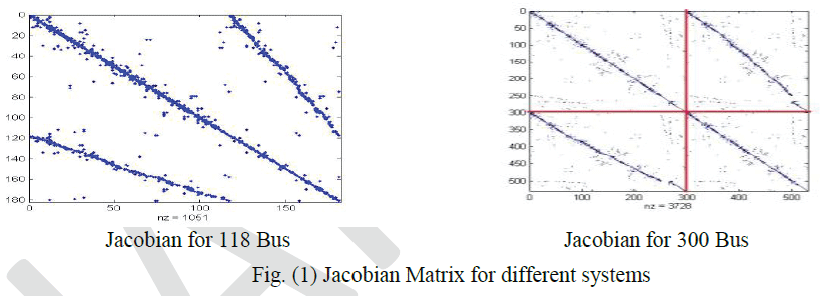 |
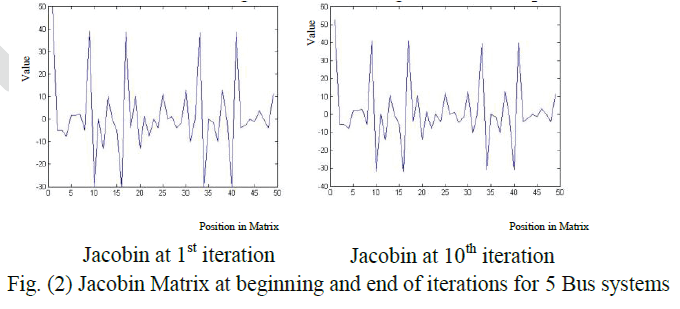 |
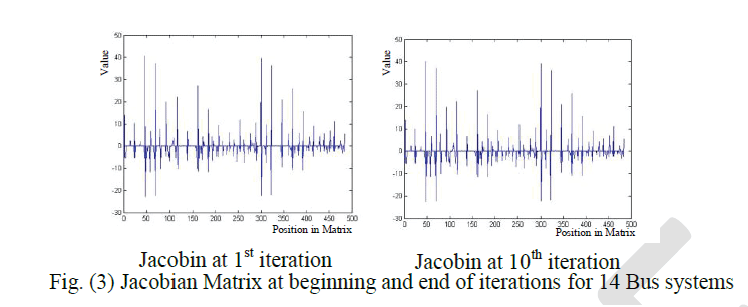 |
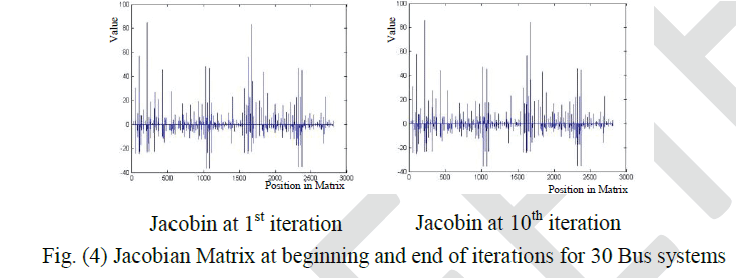 |
| Figure 1 |
Figure 2 |
Figure 3 |
Figure 4 |
 |
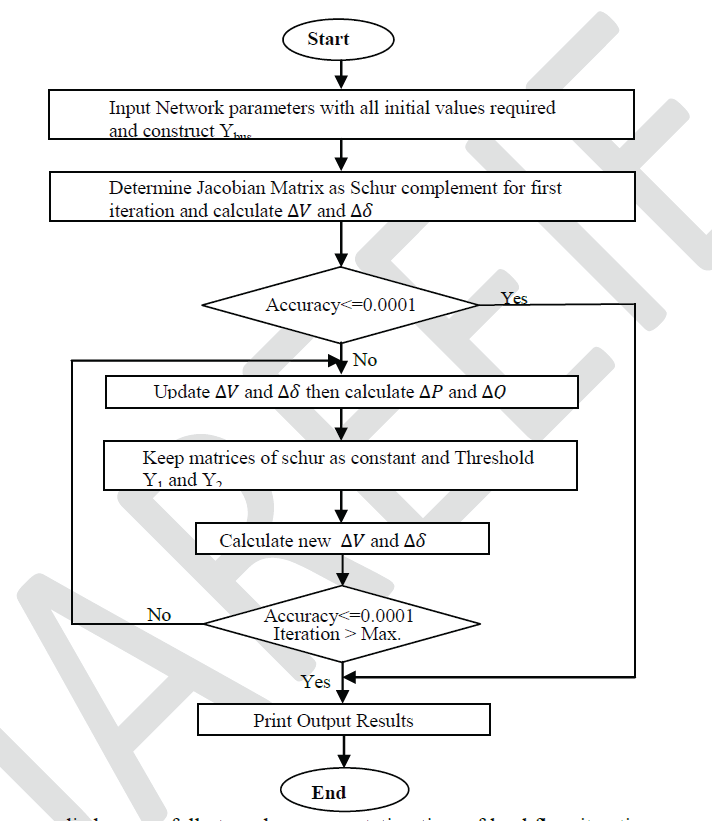 |
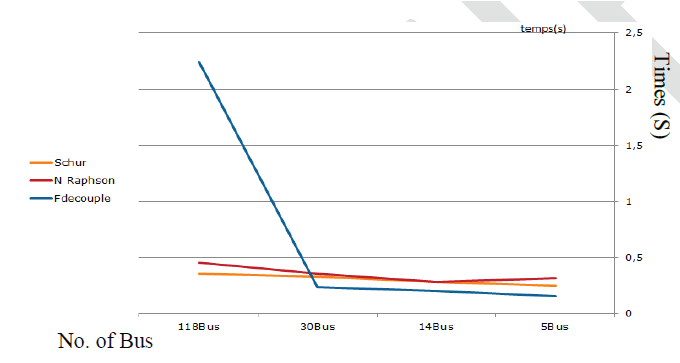 |
| Figure 5 |
Figure 6 |
Figure 7 |
|
References |
- J.B. Ward and H.W. Ha'le, "Digital Computer Solution of Power Flow Problems", Transactions of the American Institute of Electrical Engineers, vol.75, Issue 3, pp. 398-404, 1956.
- J.E. Van Ness, "Iteration Methods for Digital Load Flow Studies", Transactions of the American Institute of Electrical Engineers, vol.78, Issue 3, pp. 583-588, 1959.
- W.F. Tinney and C.E. Hart, "Power Flow Solution by Newton's Method", IEEE Transactions on Power Apparatus and Systems, vol. PAS-86, Issue 11, pp. 1449-1456, 1967.
- B. Stott and O. Alsac, "Fast Decoupled Load Flow", IEEE Transactions on Power Apparatus and Systems, vol. PAS-93, Issue 3, pp. 859, 1974.
- S. Iwamoto and Y. Tamura, "A Fast Load Flow Method Retaining Nonlinearity", IEEE Transactions on Power Apparatus and Systems, vol. PAS-97, Issue 5, pp. 1586-1599, 1978.
- G. X. Luo and A. Semlyen, “Efficient Load Flow for Large Weakly Meshed Networks”, IEEE Transactions on Power Systems, vol. 5, Issue 4, pp. 1309–1316, 1990.
- A. Semlyen, “Fundamental Concepts of a Krylov Subspace Power Flow Methodology”, IEEE Transactions on Power Systems, vol. 11, Issue 3, pp. 1528–1537, 1995.
- A. J. Flueck and H. D. Chiang, “Solving the Nonlinear Power Flow Equations with an Inexact Newton Method using GMRES”, IEEE Transactions on Power Systems, vol. 13, Issue 2, pp. 267–273, 1998.
- Y. Chen and C. Shen, “A Jacobian-free Newton-GMRES(m) Method with Adaptive Preconditioner and Its Application for Power Flow Calculations”, ”, IEEE Transactions on Power Systems, vol. 21, Issue 3, pp. 1096–1103, 2006.
- L. M. C. Braz, C. A. Castro, and C. A. F. Murari, “A Critical Evaluation of Step Size Optimization Based Load Flow Methods”, IEEE Transactions on Power Systems, vol. 15, Issue 1, pp. 202–207, 2000.
- P. R. Bijwe and S. M. Kelapure, “Nondivergent Fast Power Flow Methods”, IEEE Transactions on Power Systems, vol. 18, Issue 2, pp. 633–638, 2003.
- J. E. Tate and T. J. Overbye, “A Comparison of the Optimal Multiplier in Polar and Rectangular Coordinates”, IEEE Transactions on Power Systems, vol. 20, Issue 4, pp. 1667–1674, 2005.
- Rui Bo and Fangxing Li, "Power Flow Studies Using Principal Component Analysis", 40th North American Power Symposium, pp. 1–6, 2008.
- M. F. Bedriñana and C. A. Castro, "Step Size Optimization Based Interior Point Algorithm: Applications and Treatment of Ill conditioning in Optimal Power Flow Solutions", IEEE Power and Energy Society General Meeting, pp. 1-8, 2009.
- F. Milano,"Continuous Newton’s Method for Power Flow Analysis", IEEE Transactions on Power Systems, Vol. 24, Issue 1, pp. 50-57, 2009.
- HadiSaadat, "Power System Analysis", McGraw-Hill, 1999.
- P. Aristidou, D. Fabozzi, and T. V. Cutsem, "Dynamic Simulation of Large-scale Power Systems Using a Parallel Schur-complement-based Decomposition Method", IEEE Transactions on Parallel and Distributed Systems, Vol. PP, Issue 99, 2013 .
- D. Guibert, D. Tromeur-Dervout, "A Schur Complement Method for DAE/ODE Systems in Multi-Domain Mechanical Design", Lecture Notes in Computational Science and Engineering, Vol. 60, pp. 535–541, 2008.
|
 |
 |